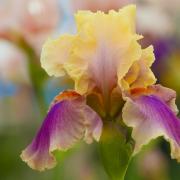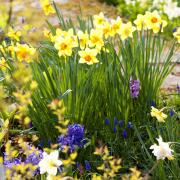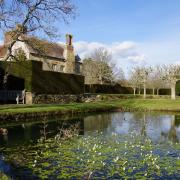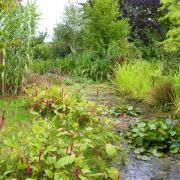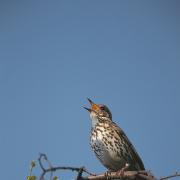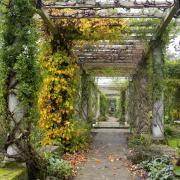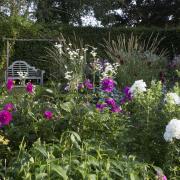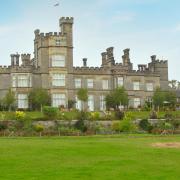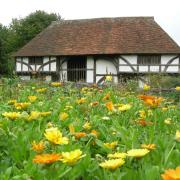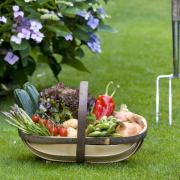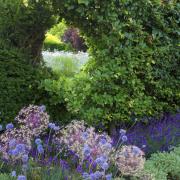Leigh Clapp meets garden designer Amanda Patton, whose designs combine naturalistic planting with a modern framework

January is a great time to plan ahead for the coming year. Maybe you are thinking of revamping an area, refreshing planting or having a totally new design created this year. Calling in a local garden designer may be just what you need to clarify your thoughts and to get the most out of the garden, taking advantage of their honed ability to create a cohesive whole.
From her base near Storrington, Amanda Patton, a Registered Member of Society of Garden Designers, offers a garden design service across the south of England. “My work focuses on creating modern gardens, using predominantly natural materials with a naturalistic planting style. I am inspired by the beauty that is all around us,” she explains.
After 20 years as a professional illustrator, including all but one of Alan Titchmarsh’s gardening books, Amanda changed direction and set up Amanda Patton Garden and Landscape Design in 2000. A visit to an artist friend’s garden had opened her eyes to the creative use of plants in a vision of colour, texture and movement, then followed by the process of creating her own home garden, these two experiences became catalysts for change. “Painting and drawing remain key to keeping me inspired and curious,” she adds. As well as using software to create plans, drawings and models, her skills allow wonderful freehand drawings and computer-generated illustrations so that clients can fully visualise the proposed design.
“I am influenced by natural light and landscape; what I find interesting is harnessing this raw nature and making it work for a garden space. I’ve also always been fascinated with tonal counterpoint – where warm colour becomes cool and light becomes dark, and the visual interest, tension and harmonies that can be exploited as a result – and I explore these themes in my paintings as well as in garden settings. In practical terms, this means creating the interest between hard and soft landscape surfaces, which is why, I think, I am equally interested in the design of the hard landscaping elements and the planting. This is quite unusual for a garden designer, as most tend to have strengths in one or the other,” Amanda says of her style.
Working with the architecture of the house and the site, Amanda’s gardens have a contemporary feel in an understated way, with strong structural elements such as paving and clipped forms in-filled with semi or stylised naturalistic planting schemes. Favourite plants to use in the Sussex gardens she designs include the slender spires of Digitalis ferrunginea, Pennisetum alopecuroides with their incandescent flower heads glowing when backlit, sweetly scented Sarcococcoa confusa clipped into shape, effervescent Salvia nemorosa ‘Caradonna’ and Stipa gigantea that Amanda describes as ‘a wonderful, tall airy grass that constantly moves and captures light – it invigorates every planting scheme’.
After an informal meeting with clients, chatting about their needs, styles and what they would like to achieve, there is a structured approach to the design phases of concept, detail, specifications and planting. “The quality of the build is very important to me – making a garden is a big financial commitment and I want to make sure that my gardens are built to last, with true craftsmanship and the right materials for the job – not necessarily the most expensive. Once complete, I like to revisit once or twice a year to see how it’s all going; a total service from start to finish,” she explains.
Amanda Patton Garden and Landscape Design; 01903 740293; info@amandapatton.co.uk; www.amandapatton.co.uk***
Amanda’s predictions for trends in 2014
We are still heading towards a more natural, sustainable approach, managing landscape so that gardens blur the boundaries between what is a garden and what is natural.
When combined within a framework with a simple and modern aesthetic, this will create restful spaces.
Less maintenance than traditional herbaceous borders.
Paring down to key elements.
Balance between understatement and seasonal variation.
--------------------------------------------------------------------
Leigh Clapp’s action plan for January
Plant of the month - Mahonia
Common name: lily of the valley bush
Evergreen shrub
Honey-scented, yellow winter flowers
Large, spiny leaves
Purple-black berries
Growing notes
Hardy
Easy to grow
Full sun to part shade
Fertile, well-drained light soil
Look good at the back of a border
Prune lightly after flowering
Cuttings from late summer to autumn
***
Clean and clear
Continue to clean, clear, compost, tidy and prepare beds. Protect plants from the elements. Check fleeces, move plants to warmer spots. Recycle your Christmas tree for mulch. Ventilate the greenhouse on sunny days. Brush heavy snow off trees. Order summer-flowering seeds and bulbs. Check any stored produce and tubers for rot and remove.
***
Feed the birds
Top up water and food for birdlife. Ideally your garden will have natural food and habitat plants. If you need to augment, remember to put out water and good quality food regularly with a routine, adjusted to the demands of your winged visitors. Clear away uneaten food from the feeders, as good
hygiene is vital to the health of the birds.
***
Rosy thoughts
Bare-root roses can be planted now if ground is not frozen. It’s a good idea to prepare soil a few weeks before planting. Once you have the bare-root roses, plant them as soon as possible. Mix in organic matter, apply fertiliser once planted and fork in on the surface. Don’t plant where a rose has been before, to avoid replant disease.




